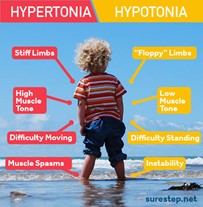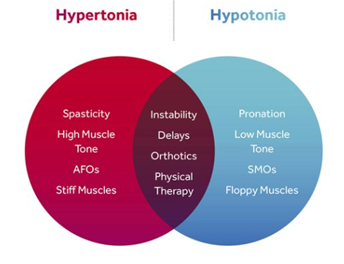Muscle Tone: High vs Low
Posted on April 5th, 2022 by Andries Lodder
What is “Muscle Tone”?
A term you may have heard alot is “muscle tone”. But what actually is muscle tone? Why is muscle tone important? These are the most common questions one usually asks around the topic.
Hypotonicity (Low muscle tone) is used to describe muscles that are “floppy” and stretched. People with low muscle tone may need to put in more effort to get their muscles moving properly when they are doing an activity. They may also have difficulty maintaining good posture when sitting or standing. Many children with low muscle tone have delays in their gross motor development. On the other hand, hypertonicity (High muscle tone) describes muscles that are overly tight and require more effort to stretch and lengthen. This also affects one’s movement during regular activities of daily living, one’s posture and can lead to different degrees of spasticity.
Why is Muscle Tone Important?
There are three main functions for muscle tone:
- Muscle tone helps maintain posture and helps muscles resist the forces of gravity. This is simply your ability to remain centered and balanced while at rest. The less muscle tone, the more uneven you are physically and the more prone you become to injury or muscular-skeletal stress.
- Muscle tone stores energy. It retains energy and makes it possible to release that energy when you need it. This is the case even for something as simple as walking.
- Muscle tone operates like a spring. Toned and fit muscles help absorb shock and stress even from ordinary movements. For people who exercise, this type of function can be crucial for further muscle development and to avoid injuries.
It is important to recognize that muscle groups are all connected. The way we maintain balance and the ways in which we compensate for uneven stress on the body is largely dependent upon muscle tone. By having a basic tension in the muscles, our bodies are able to move and exert without running the risk of injury or undue strain.
Muscle tone contributes to physiological function over the entire body. Some of the key areas that make muscle tone important are:
- Posture: Muscle tone ensures that your relaxed state maintains a balance posture. Without muscle tone, stress on the spine and skeletal system begin to weigh in varying directions. This can result in spinal problems and back pain. Properly tones muscle scahttps://nfsports.com/blogs/supplements/muscle-tonen even decrease the likelihood of osteoporosis.
- Stamina and Immune system: Muscle tone tends to reduce weight and body fat. This leads to a healthier heart, increased stamina, and flexible joints. This reduces the likelihood of diabetes and cardiovascular diseases.
- Skeletal-muscular balance: Muscle tone serves to balance the strains over the body. Rather than allowing one set of muscles to bear the burden of physical stress, tones muscle distributes these stresses over the muscular-skeletal system. This reduces the strain on muscles, ligaments, and tendons.
- Better sleep: Muscle tone is linked to REM sleep. REM sleep cycles, or rapid eye movement, is part of the natural sleep cycle. This also the time during sleep that muscle tone completely relaxes. A lack of muscle tone will impact the quality of REM sleep cycles and this will have a negative effect on sleep overall.
Hypertonicity
This can occur for many reasons:
- A blow to the head
- Stroke
- brain tumors
- Toxins that affect the brain
- Multiple Sclerosis
- Parkinson’s disease
- Cerebral palsy
Hypertonia often limits how easily the joints can move. Symptoms include:
- Loss of function
- Decreased range of movement
- Rigidity of muscles
- Spasticity of muscles
- Deformity
- Tenderness and pain
- Rapid muscle contractions,
- Involuntary crossing of legs
Hypotonicity
Hypotonia is a medical term used to describe decreased muscle tone. Normally, even when relaxed, muscles have a very small amount of contraction that gives them a “springy” feel and provides some resistance to passive movement. It is not the same as muscle weakness, although the two conditions can co-exist.
Hypotonia can happen from damage to the brain, spinal cord, nerves, or muscles. The damage can be the result of:
Hypotonia is more commonly seen in:
- Down syndrome
- Muscular dystrophy
- Cerebral Palsy
- Prader-Willi Syndrome
- Myotonic Dystrophy
- Tay-Sachs Disease.
The most common symptoms of Hypotonia include:
- Loss of function
- Decreased range of movement (ROM)
- Laxness of Muscles
- Deformity
- Tenderness and pain
- Slow Muscle Contractions
There are a few differences in the treatment of both, hypertonia and hypotonia. However, many of the treatment protocols do overlap. Your biokineticist will know when to apply each protocol.
Treatment for Hypertonicity:
- Postural Correction
- Stretching of Muscles
- PNF Stretches
- Exercises to Improve Neuromuscular control and feedback
- Eccentric Exercises
- Co-ordination Exercises
Treatment for Hypotonicity:
- Postural Correction
- Postural Strengthening
- Strengthening Exercises
- Exercises to Improve Neuromuscular control and feedback
- Isometric Exercises
- Concentric Exercises
- Co-ordination Exercises
Tweet

